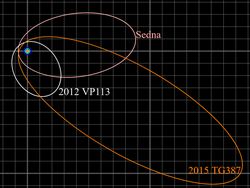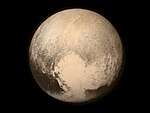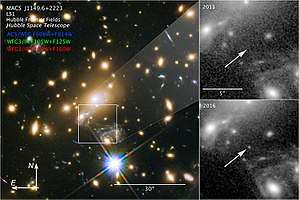541132 Leleākūhonua
541132 Leleākūhonua, provisionally designated 2015 TG387, is an extreme trans-Neptunian object and sednoid in the outermost part of the Solar System. It was first observed on 13 October 2015, by astronomers at the Mauna Kea Observatories, Hawaii. Based on its discovery date and the letters in its provisional designation 2015 TG387, the object was informally nicknamed "The Goblin" by its discoverers[4] and later named Leleākūhonua, a life form mentioned in the Hawaiian religion. It was the third sednoid discovered, after Sedna and 2012 VP113, and measures approximately 110 kilometers (68 miles) in diameter.[10]
 | |
| Discovery[1][2] | |
|---|---|
| Discovered by | D. J. Tholen C. Trujillo S. S. Sheppard |
| Discovery site | Mauna Kea Obs. |
| Discovery date | 13 October 2015 |
| Designations | |
| (541132) Leleākūhonua | |
Named after | Leleākūhonua[1][3] (Hawaiian mythology) |
| TNO[7] · sednoid[8][9] | |
| Orbital characteristics[7] | |
| Epoch 31 May 2020 (JD 2459000.5) | |
| Uncertainty parameter 4[7] · 1[1] | |
| Observation arc | 3.01 yr (1,101 d) |
| Aphelion | 2106±216 AU |
| Perihelion | 65.16±0.21 AU |
| 1085±111 AU | |
| Eccentricity | 0.93997±0.00636 |
| 35760±5510 yr | |
| 359.418° | |
| 0° 0m 0.099s / day | |
| Inclination | 11.654° |
| 300.780° | |
| 117.778° | |
| Physical characteristics | |
Mean diameter | 110+14 −10 km[10] |
| 0.21+0.03 −0.05[10] | |
| 24.5[11] | |
| 5.50±0.13[1][7] | |
Discovery
Leleākūhonua was first observed on 13 October 2015 at the Mauna Kea Observatory (T09), by American astronomers David Tholen, Chad Trujillo and Scott Sheppard during their astronomical survey for objects located beyond the Kuiper Cliff.[1][2] The unofficial discovery was publicly announced on 1 October 2018.[2][12] The survey uses two principal telescopes: For the Northern hemisphere, the 8.2-meter Subaru Telescope with its Hyper Suprime Camera at Mauna Kea Observatories, Hawaii, and for the Southern hemisphere, the 4-meter Blanco telescope and its Dark Energy Camera at Cerro Tololo Inter-American Observatory in Chile. For follow-up observations to determine an object's orbit, the astronomers are using the Magellan and the Discovery Channel telescopes. The survey's discoveries include 2012 VP113, 2014 SR349 and 2013 FT28.[8]
Orbit and classification
Leleākūhonua orbits the Sun at a distance of 65–2000 AU once roughly every 32,000 years (semi-major axis of ~1080 AU). Its orbit has a very high eccentricity of 0.94 and an inclination of 12° with respect to the ecliptic.[7] It belongs to the extreme trans-Neptunian objects defined by their large semi-major axis and is the third sednoid ever to be discovered, after Sedna and 2012 VP113 ("Biden").
Implications of orbit
Along with the similar orbits of other distant trans-Neptunian objects, the orbit of Leleākūhonua suggests, but does not prove, the existence of a hypothetical Planet Nine in the outer Solar System.[8][13]
As of 2019, the object is inbound 78 AU from the Sun;[11] about two-and-a-half times farther out than Pluto's current location.[5] It will come to perihelion (closest approach to the Sun) in 2078.[7] As with Sedna, it would not have been found had it not been on the inner leg of its long orbit. This suggests that there may be many similar objects, most too distant to be detected by contemporary technological methods. Following the discovery of Leleākūhonua, Sheppard et al. concluded that it implies a population of about 2 million inner Oort cloud objects larger than 40 km (25 mi), with a combined total mass of 1×1022 kg, which is several times the mass of the asteroid belt.[8]
Numbering and naming
This minor planet has been numbered by the Minor Planet Center on 10 October 2019 (M.P.C. 117077).[14] In June 2020, it was formally named Leleākūhonua, a life form mentioned in the Hawaiian creation chant, the Kumulipo. The discoverers state in their citation that "the name compares the orbit to the flight of migratory birds and evokes a yearning to be near Earth".[1][3]
Physical characteristics
The size of Leleākūhonua depends on the assumed albedo (reflectivity); if it is a darker object then it would also have to be larger; a higher albedo would demand that it be smaller.[15] The faint object has a visual magnitude of 24.64, comparable to the visual magnitudes of Pluto's smaller moons.[11][15] It was initially estimated to be 300 km (190 mi) in diameter under the assumption of an albedo of 0.15,[8] though observations of a single-chord stellar occultation at Penticton, Canada on 20 October 2018 suggested a smaller diameter of 110 km (68 mi), corresponding to a high albedo of 0.21.[10]
Visualizations
 Simulated view of Solar System as seen from Leleākūhonua, showing the orbits of major planets and positions of other extreme trans-Neptunian objects.
Simulated view of Solar System as seen from Leleākūhonua, showing the orbits of major planets and positions of other extreme trans-Neptunian objects. View of Leleākūhonua from Earth, showing retrograde loops every year, with current position near γ Pegasi
View of Leleākūhonua from Earth, showing retrograde loops every year, with current position near γ Pegasi
See also
References
- "(541132) Leleakuhonua = 2015 TG387". Minor Planet Center. Retrieved 21 October 2019.
- "MPEC 2018-T05 : 2015 TG387". Minor Planet Electronic Circular. 1 October 2018. Retrieved 13 December 2018.
- "M.P.C. 45236" (PDF). Minor Planet Center. International Astronomical Union. 3 June 2020. Retrieved 15 June 2019.
- Guarino, Ben (2 October 2018). "New dwarf planet spotted at the very fringe of our solar system". The Washington Post. Retrieved 3 October 2018.
- Chang, Kenneth (2 October 2018). "A Goblin World That Points Toward Hidden Planet Nine in the Solar System". The New York Times. Retrieved 2 October 2018.
- Trujillo, C.; Sheppard, S.S.; Tholen, D.J.; Kaib, N. (24 October 2018). A New Inner Oort Cloud Object. 50th annual meeting of the AAS Division of Planetary Sciences. abstract 311.09. Retrieved 19 October 2018.
- "JPL Small-Body Database Browser: (2015 TG387)" (2018-10-17 last obs.). Jet Propulsion Laboratory. Retrieved 13 December 2018.
- Sheppard, Scott S.; Trujillo, Chadwick A.; Tholen, David J.; Kaib, Nathan (April 2019). "A New High Perihelion Trans-Plutonian Inner Oort Cloud Object: 2015 TG387". The Astronomical Journal. 157 (4): 139. arXiv:1810.00013. Bibcode:2019AJ....157..139S. doi:10.3847/1538-3881/ab0895. ISSN 0004-6256.
- Johnston, Wm. Robert (13 July 2019). "List of Known Trans-Neptunian Objects". Johnston's Archive. Retrieved 21 October 2019.
- Buie, Marc W.; Leiva, Rodrigo; Keller, John M.; Desmars, Josselin; Sicardy, Bruno; Kavelaars, J. J.; et al. (April 2020). "A Single-chord Stellar Occultation by the Extreme Trans-Neptunian Object (541132) Leleākūhonua". The Astronomical Journal. 159 (5). Bibcode:2020AJ....159..230B. doi:10.3847/1538-3881/ab8630. 230.
- "2015 TG387 – Ephemerides". AstDyS-2, Asteroids – Dynamic Site, Department of Mathematics, University of Pisa, Italy. Retrieved 12 December 2018.
- Mortillaro, Nicole (2 October 2018). "Discovery of new object supports theory of 'super-Earth' at edge of solar system". CBC News. Retrieved 2 October 2018.
- Witze, Alexandra (1 October 2018). "'Goblin' world found orbiting at the edges of the Solar System". Nature. doi:10.1038/d41586-018-06885-1. Retrieved 2 October 2018.
- "MPC/MPO/MPS Archive". Minor Planet Center. Retrieved 21 October 2019.
- Drake, Nadia (2 October 2018). "New object beyond Pluto hints at mysterious 'Planet X'". National Geographic. Retrieved 11 October 2018.
External links
- List Of Centaurs and Scattered-Disk Objects, Minor Planet Center
- 541132 Leleākūhonua at AstDyS-2, Asteroids—Dynamic Site
- 541132 Leleākūhonua at the JPL Small-Body Database





